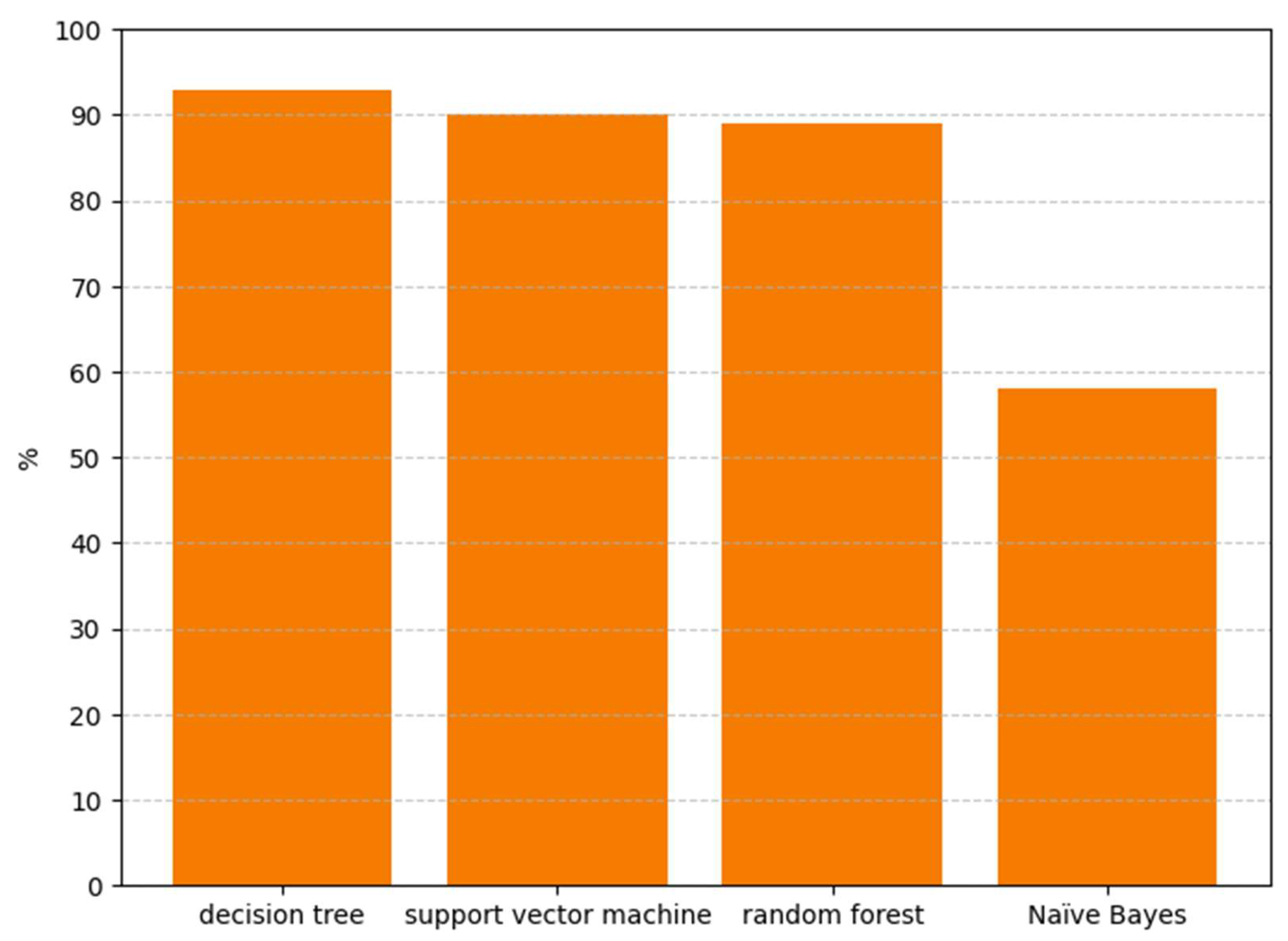Analyzing and Predicting Alcohol or Non-Alcoholic Cocktails †
Abstract
1. Introduction
2. Literature Review
- Masculine: Whiskey, beer, soda, energy drinks, and protein shakes.
- Feminine: Wine, mixed drinks, diet soda, iced tea, and fruit drinks.
3. Methodology
4. Result
5. Conclusions
Author Contributions
Funding
Institutional Review Board Statement
Informed Consent Statement
Data Availability Statement
Conflicts of Interest
References
- Lee, B.P.; Witkiewitz, K.; Mellinger, J.; Anania, F.A.; Bataller, R.; Cotter, T.G.; Curtis, B.; Dasarathy, S.; DeMartini, K.S.; Diamond, I.; et al. Designing clinical trials to address alcohol use and alcohol-associated liver disease: An expert panel Consensus Statement. Nat. Rev. Gastroenterol. Hepatol. 2024, 21, 626–645. [Google Scholar] [CrossRef] [PubMed]
- Newsverge. Inflation: Soft, Alcoholic Drinks Dealers Groan Under Soaring Prices, Low Purchases [Photograph]. 17 February 2024. Available online: https://newsverge.com/2024/02/17/inflation-soft-alcoholic-drinks-dealers-groan-under-soaring-prices-low-purchases/ (accessed on 1 January 2025).
- Dobashi, S.; Kawaida, K.; Saito, G.; Owaki, Y.; Yoshimoto, H. Gender differences in changes in alcohol consumption achieved by free provision of non-alcoholic beverages: A secondary analysis of a randomized controlled trial. BMC Public Health 2024, 24, 150. [Google Scholar] [CrossRef] [PubMed]
- Waehning, N.; Wells, V. Product, individual and environmental factors impacting the consumption of no and low alcoholic drinks: A systematic review and future research agenda. Food Qual. Prefer. 2024, 117, 105163. [Google Scholar] [CrossRef]
- Kaminska, A.; Dmowski, P.; Marjańska, E. Availability conditions as a critical factor in product category management in shaping the offer of non-alcoholic equivalents of alcoholic beverages. Zesz. Nauk. Politech. Śl. 2024, 207, 212–228. [Google Scholar]
- Bowdring, M.; Rutledge, G.; Prochaska, J. Advising patients on the use of non-alcoholic beverages that mirror alcohol. Prev. Med. Rep. 2024, 47, 102888. [Google Scholar] [CrossRef] [PubMed]
- Harvey, A.; Beaman, C. Acute alcohol intoxication and the cocktail party problem: Do ‘mocktails’ help or hinder? Psychopharmacology 2021, 238, 3083–3093. [Google Scholar] [CrossRef] [PubMed]
- Rajendran, C. Effect of weekend alcohol consumption on Blood Pressure control in Non-alcoholic patients engaging in social drinking. Int. J. Sci. Res. 2024, 11, 11–12. [Google Scholar] [CrossRef]
- Nanchahal, K.; Vasiljevic, M.; Petticrew, M. A content analysis of the aims, strategies, and effects of food and nonalcoholic drink advertising based on advertising industry case studies. Open Sci. Policy 2022, 8, 208–218. [Google Scholar] [CrossRef] [PubMed]
- Perman-Howe, P.; Holmes, J.; Brown, J.; Kersbergen, I. Characteristics of consumers of alcohol-free and low-alcohol drinks in Great Britain: A cross-sectional study. Drug Alcohol Rev. 2024, 43, 1686–1697. [Google Scholar] [CrossRef] [PubMed]
- Saxov, K.; Pristed, S.; Kesmodel, U. Characteristic associated with alcohol drinking in early pregnancy: A cross sectional study. Sci. Rep. 2023, 13, 10925. [Google Scholar] [CrossRef] [PubMed]
- Robinson, E.; Boyland, E.; Evans, R.; Finlay, A.; Halsall, L.; Humphreys, G.; Langfield, T.; McFarland-Lesser, I.; Patel, Z.; Jones, A. Energy labelling of alcoholic drinks: An important or inconsequential obesity policy? Open Sci. Policy 2023, 9, 75–86. [Google Scholar] [CrossRef] [PubMed]
- Musto, J.; Brown, R.; Lucey, M. Is there a safe limit for consumption of alcohol? J. Hepatol. 2024, 82, 535–540. [Google Scholar] [CrossRef] [PubMed]
- Wilson, S.E.; Lavoie, H.A.; Berey, B.L.; Frohe, T.; Rowland, B.H.P.; Hone, L.S.E.; Leeman, R.F. Exploratory analysis of blood alcohol concentration-related technology use and drinking outcomes among young adults. Alcohol Clin. Exp. Res. 2024, 48, 2188–2199. [Google Scholar] [CrossRef] [PubMed]
- Pinar, M.; Ekebas-Turedi, C.; Basfirinci, C. Gender-Based Drink Stereotypes and Consumption Intentions: A Study With the U.S. Millennials. J. Mark. Dev. Compet. 2021, 15, 72–82. [Google Scholar]
- Karunarathna, I.; De Alvis, K.; Gunasena, P.; Jayawardana, A. Understanding Alcohol-Related Oxidative Stress and Its Implications for Chronic Disease. 2024. Available online: https://www.researchgate.net/publication/382801097 (accessed on 14 August 2025).
- Malnick, S.; Alin, P.; Somin, M.; Neuman, M. Fatty Liver Disease-Alcoholic and Non-Alcoholic: Similar but Different. Int. J. Mol. Sci. 2022, 23, 16226. [Google Scholar] [CrossRef] [PubMed]
- De Alvis, K.; Gunasena, P.; Jayawardana, A. Unraveling the complex relationship between alcohol and cancer risk: Effects of alcohol on health. Res. Sq. 2024. [Google Scholar] [CrossRef]
- Diwaker, C.; Tomar, P.; Solanki, A.; Nayyar, A.; Jhanjhi, N.Z.; Abdullah, A.; Supramaniam, M.A. A New Model for Predicting Component-Based Software Reliability Using Soft Computing. IEEE Access 2019, 7, 147191–147203. [Google Scholar] [CrossRef]
- Kok, S.H.; Abdullah, A.; Jhanjhi, N.Z.; Supramaniam, M.A. A review of intrusion detection system using machine learning approach. Int. J. Eng. Res. Technol. 2019, 12, 8–15. [Google Scholar]


| Model | Accuracy |
|---|---|
| Decision Tree | 95% |
| Support Vector Machines | 92% |
| Random Forest | 88% |
| Naive Bayes | 59.6% |
Disclaimer/Publisher’s Note: The statements, opinions and data contained in all publications are solely those of the individual author(s) and contributor(s) and not of MDPI and/or the editor(s). MDPI and/or the editor(s) disclaim responsibility for any injury to people or property resulting from any ideas, methods, instructions or products referred to in the content. |
© 2025 by the authors. Licensee MDPI, Basel, Switzerland. This article is an open access article distributed under the terms and conditions of the Creative Commons Attribution (CC BY) license (https://creativecommons.org/licenses/by/4.0/).
Share and Cite
Khan, H.; Rehman, A.U.; Fergina, A. Analyzing and Predicting Alcohol or Non-Alcoholic Cocktails. Eng. Proc. 2025, 107, 48. https://doi.org/10.3390/engproc2025107048
Khan H, Rehman AU, Fergina A. Analyzing and Predicting Alcohol or Non-Alcoholic Cocktails. Engineering Proceedings. 2025; 107(1):48. https://doi.org/10.3390/engproc2025107048
Chicago/Turabian StyleKhan, Hifza, Attique Ur Rehman, and Anggun Fergina. 2025. "Analyzing and Predicting Alcohol or Non-Alcoholic Cocktails" Engineering Proceedings 107, no. 1: 48. https://doi.org/10.3390/engproc2025107048
APA StyleKhan, H., Rehman, A. U., & Fergina, A. (2025). Analyzing and Predicting Alcohol or Non-Alcoholic Cocktails. Engineering Proceedings, 107(1), 48. https://doi.org/10.3390/engproc2025107048






